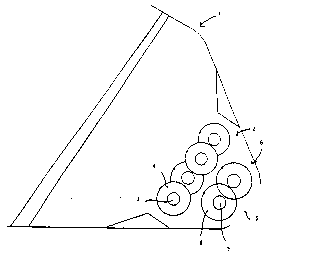Some of the information on this Web page has been provided by external sources. The Government of Canada is not responsible for the accuracy, reliability or currency of the information supplied by external sources. Users wishing to rely upon this information should consult directly with the source of the information. Content provided by external sources is not subject to official languages, privacy and accessibility requirements.
Any discrepancies in the text and image of the Claims and Abstract are due to differing posting times. Text of the Claims and Abstract are posted:
| (12) Patent Application: | (11) CA 2138771 |
|---|---|
| (54) English Title: | APPARATUS |
| (54) French Title: | APPAREIL |
| Status: | Deemed Abandoned and Beyond the Period of Reinstatement - Pending Response to Notice of Disregarded Communication |
| (51) International Patent Classification (IPC): |
|
|---|---|
| (72) Inventors : |
|
| (73) Owners : |
|
| (71) Applicants : | |
| (74) Agent: | AVENTUM IP LAW LLP |
| (74) Associate agent: | |
| (45) Issued: | |
| (86) PCT Filing Date: | 1993-06-23 |
| (87) Open to Public Inspection: | 1994-01-06 |
| Examination requested: | 2000-05-24 |
| Availability of licence: | N/A |
| Dedicated to the Public: | N/A |
| (25) Language of filing: | English |
| Patent Cooperation Treaty (PCT): | Yes |
|---|---|
| (86) PCT Filing Number: | PCT/FI1993/000268 |
| (87) International Publication Number: | WO 1994000644 |
| (85) National Entry: | 1994-12-21 |
| (30) Application Priority Data: | ||||||
|---|---|---|---|---|---|---|
|
2138771 9400644 PCTABS00030
The invention relates to a device for handling material,
especially soil, the device comprising a bucket (1) of a machine having a
grinding device (2) for the material fitted thereto, the
grinding device comprising at least two essentially parallel shafts (3)
which are set at a distance from each other and rotatable in
synchronization, the shafts comprising grinding members (4) for the
material, whereby the grinding members (4) of two adjacent shafts
overlap each other, the bottom of the bucket (1) comprising an
outlet opening (5) for the handled material. According to the
invention the grinding members are comprised of numerous discs (4)
which are set at a distance from each other on each shaft (3), the
peripheral surfaces of the discs comprising projections, whereby a
notch is provided between two adjacent projections. In addition,
the bucket (1) comprises a loosening device (6) for the material
fitted between the grinding device (2) and the outlet opening
(5), the loosening device comprising at least two essentially
parallel shafts (7) which are set at a distance from each other and
rotatable in synchronization and which comprise aeration blades (8)
for loosening the ground material obtained from the grinding
device (2).
Note: Claims are shown in the official language in which they were submitted.
Note: Descriptions are shown in the official language in which they were submitted.

2024-08-01:As part of the Next Generation Patents (NGP) transition, the Canadian Patents Database (CPD) now contains a more detailed Event History, which replicates the Event Log of our new back-office solution.
Please note that "Inactive:" events refers to events no longer in use in our new back-office solution.
For a clearer understanding of the status of the application/patent presented on this page, the site Disclaimer , as well as the definitions for Patent , Event History , Maintenance Fee and Payment History should be consulted.
| Description | Date |
|---|---|
| Inactive: Adhoc Request Documented | 2018-06-06 |
| Revocation of Agent Requirements Determined Compliant | 2018-05-18 |
| Appointment of Agent Requirements Determined Compliant | 2018-05-18 |
| Inactive: IPC from MCD | 2006-03-11 |
| Application Not Reinstated by Deadline | 2002-06-25 |
| Time Limit for Reversal Expired | 2002-06-25 |
| Inactive: Abandoned - No reply to s.30(2) Rules requisition | 2001-08-27 |
| Deemed Abandoned - Failure to Respond to Maintenance Fee Notice | 2001-06-26 |
| Inactive: S.30(2) Rules - Examiner requisition | 2001-02-27 |
| Amendment Received - Voluntary Amendment | 2000-11-01 |
| Inactive: Application prosecuted on TS as of Log entry date | 2000-07-06 |
| Letter Sent | 2000-07-06 |
| Inactive: Status info is complete as of Log entry date | 2000-07-06 |
| All Requirements for Examination Determined Compliant | 2000-05-24 |
| Request for Examination Requirements Determined Compliant | 2000-05-24 |
| Application Published (Open to Public Inspection) | 1994-01-06 |
| Abandonment Date | Reason | Reinstatement Date |
|---|---|---|
| 2001-06-26 |
The last payment was received on 2000-05-24
Note : If the full payment has not been received on or before the date indicated, a further fee may be required which may be one of the following
Please refer to the CIPO Patent Fees web page to see all current fee amounts.
| Fee Type | Anniversary Year | Due Date | Paid Date |
|---|---|---|---|
| MF (application, 4th anniv.) - small | 04 | 1997-06-23 | 1997-06-05 |
| MF (application, 5th anniv.) - small | 05 | 1998-06-23 | 1998-06-04 |
| MF (application, 6th anniv.) - small | 06 | 1999-06-23 | 1999-05-31 |
| MF (application, 7th anniv.) - small | 07 | 2000-06-23 | 2000-05-24 |
| Request for examination - small | 2000-05-24 |
Note: Records showing the ownership history in alphabetical order.
| Current Owners on Record |
|---|
| MIKKO YRJOLA |
| Past Owners on Record |
|---|
| None |